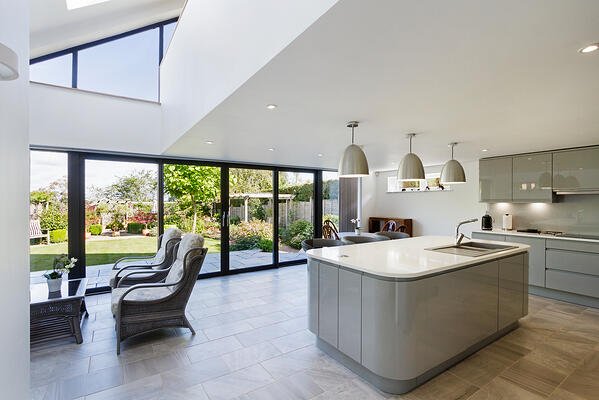
The Impending Climate Crisis
The signs of global warming are everywhere, and are more complex than just climbing temperatures.
Scientists agree that human activities have, and still are, driving a worldwide climate crisis. We all know that it's happening and we can't escape from the impact it's having on the planet. The media bombard us almost daily with horrific images and there are obvious signs all around us. Carbon pollution is warming the planet meaning that the world's natural systems are out of balance. Throw into the mix pollution and a rising global population and it's a recipe for disaster!
We don't have to look far to see the affects. Hotter temperatures, melting Arctic ice, stronger and more frequent storms, rising sea levels; all threatening our health and our existence into the future.
How things have changed
Our team are always thinking about the environment, how it's changing, what will become of us all in the future and how architecture can make a significant difference to help reverse the effects of climate change.
As Christmas is just around the corner we thought that Charles Dickens, 'A Christmas Carol' would be a good story to show how the environment has changed, where we are now and the irreversible worldwide crisis that scientists' are predicting if we don't start to make significant changes now!
So join us, as we retell the Christmas Classic with a slightly different twist as we look at the environment and design in terms of the Past, Present and Future. See how the visits from the three spirits influence Scrooge and find out if he will change into a better man who is determined to save the world from the climate crisis.
Watch below...
What can we do?
We take the warnings regarding climate change very seriously at Croft Architecture and we endeavour to help our clients to create sustainable buildings that are low-energy or even energy-positive.
Building Regulations currently dictate the minimum requirement for the energy efficiency of a building under Part L, but the regulations are not enough to help reverse the effects of climate change.
At the outset of all projects we chat with our clients and discuss the advantages of an energy efficient build. It’s not just residential clients who can benefit. Schools, offices, health care facilities, hotels or even apartments can be ultra-low energy. The basics apply to all, lower running and maintenance costs, healthier and happier environments and in there better for the environment too.
All clients, whatever the project, can gain from a more sustainable design, or even an energy positive renovation or build. It’s our responsibility as architects to educate and advise clients that a sustainable build doesn’t just help the environment.
For example, a sustainable school will benefit from lower running costs, but it also provides an educational living example for the students, providing real life evidence of how we can all live, work and grow in a sustainable environment. Everyone’s a winner!
To find out more about creating low energy or zero carbon buildings you can read more in our short blogs here.
Energy efficient, sustainable and healthy homes.
Just because projects are energy-efficient, it does not mean that clients must compromise on their design aspirations or requirements. We’ve recently had the pleasure of working with a retired couple who wanted to future proof their home to improve accessibility and use renewable sources of energy to power their home. They aspired for their home to provide level easy access throughout and they wanted to ensure that their home stayed relatively maintenance free, cheap to run and healthy to live in too. Their design resulted in a highly energy efficient home. Read more about their project here…
The UK Government has already set a 2050 target - to reduce emissions by 80%. This was previously was agreed by MP's under the Climate Change Act in 2008, but it has since been amended to the new, much stricter, goal to become "net zero" on greenhouse gases by 2050.
We know it can be done, but it unfortunately it needs policy, regulation and incentives in order for it to become ingrained into all design and business practice for all.
If you’re interested to know what zero emissions in 2050 would mean for the UK have a quick read of 'The Guardian's' insight into life in 2050…
The Committee on Climate Change says cutting greenhouse gas emissions to zero by 2050 is necessary, affordable and desirable. Here are some of the actions needed to make that happen:
- Petrol and diesel cars banned from sale ideally by 2030 and 2035 at the latest.
- Quadrupling clean electricity production from wind, solar and perhaps nuclear, plus batteries to store it and connections to Europe to share the load.
- Connection of new homes to the gas grid ending in 2025, with boilers using clean hydrogen or replaced by electric powered heat pumps. Plus, all homes and appliances being highly efficient.
- Beef, lamb and dairy consumption falling by 20%, though this is far lower than other studies recommend and a bigger shift to plant-based diets would make meeting the zero target easier.
- A fifth of all farmland – 15% of the UK – being converted to tree planting and growing bio fuel crops and restoration of peat bogs. This is vital to take CO2 out of the air to balance unavoidable emissions from cattle and planes.
- 1.5bn new trees will be needed, meaning more than 150 football pitches a day of new forests from now to 2050.
- Flying would not be banned, but the number of flights will depend on how much airlines can cut emissions with electric planes or bio fuels.
The everyday choices that we make have an impact on the environment. As we know the earth only has limited amount of natural resources, from food and water, to fossil fuels. We all have a limited amount of time to reduce the emissions and pollution in order to reverse the effects on the planet and for us all to stay healthy.
Talk to us about how we can help you to make a sustainable change with your existing building or prospect project.




